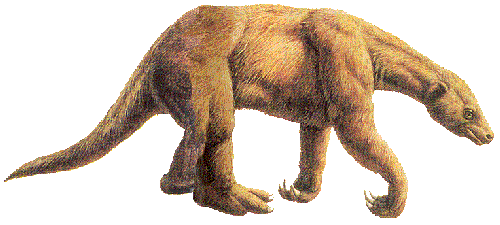A Ground Sloth in Grand Canyon
by "Canyon Dave" Thayer

The details of the life of Nothrotheriops in this story are based on knowledge gained from study of the Shasta ground sloth’s skeleton, preserved fur, and dung (showing what he ate). It is also possible to extrapolate his basic habits and physiology by comparison with his nearest living relatives, the tree sloths of South America. To give comments on this story, visit our grand canyon tours site and email Dave.
In the Rain
Twelve thousand years ago, an ice age was ending. It was late summer, rain streaming down. The southwest monsoon had
returned after almost 100,000 years. Nothrotheriops shastensis, the ground sloth, stood in the entrance of a cave that opened
onto the Tonto Platform from the base of the Redwall cliff. A puddle was filling from a steady drip in the ceiling.
Nothrotheriops looked out disinterestedly at the overcast day, cool after a hot summer.
The sun had peeked out between
thunderheads. Swirling sheets of rain in the dark distance became individual falling diamonds in the sunny foreground,
and all the rocks and cliffs were wet and glistening. The cave was a shelter, and its entrance room a gigantic brood
chamber for the local sloth population. Mountain goats sometimes shared the shelter, which felt warm in the winter,
cool in the summer, and always dim and comforting. The floor was soft with thousands of years of pungent dung-balls.
Nothrotheriops was old for a ground sloth, slower-moving even than most of his slow tribe. He was about eight feet long
with his sturdy tail, and he weighed 400 pounds. He was an herbivore. Right now his long tongue was sliding in and out
as he tasted his mouthful of bitter joint-fir. He was always chewing, or waddling to his browse, or sleeping. Being a
sloth, with a naturally slow metabolism, he was unruffled by the ephedra’s heart-stimulating chemistry. Nothrotheriops
was a primitive beast related to anteaters and armadillos, members of the Order Xenarthra, which have a reduced number
of teeth.
Lunchtime
Nothrotheriops was quite safe, the largest animal within Grand Canyon—contemporaneous mammoths and giant sloths
were not gravimetrically designed for the steep terrain. The mammoth’s chief predator, the saber-toothed cat, was absent
as well. While a desperate mountain lion might attack the old sloth, few predators would eat flesh of such a strong odor. Also,
Nothrotheriops had formidable claws on its front feet whose slashes could send any cat running, or dying.
The rain poured down, bouncing from the stones and creating a rising mist. Across the Tonto Platform, pinyon
(Pinus edulis) and juniper (Juniperus osteosperma) trees were winter-pruned to the exact height of
Nothrotheriops on his back feet with his long neck stretched out. The underbrush, which he also browsed,
was ephedra, yucca, cacti, grasses, and numerous flowering shrubs and herbaceous plants.
He felt hungry, as he usually did while awake. His primitive digestive system was relatively ineffective, requiring him
to eat proportionally more forage than the advanced mammals of his world. This took time, and he didn’t have much of that,
since he required many hours of sleep each day and night. So, walking on his front knuckles and the outside edges of his
hind feet, he ambled down the slope to eat.
Rivulets of rainwater were soon running down his reddish-brown fur. Between
tree trunks, he could see the dark shapes of seven more sloths, four of them pregnant females. Modern female tree sloths,
and so perhaps Nothrotheriops, give birth annually, and so they are pregnant for most of the year, often with a
young sloth clinging to their fur. The female will abandon these in a few months, when they are big enough to fend for
themselves.
Sleepy
Nothrotheriops stopped at a barberry bush (Berberis fremontii) that still had its dark blue berries.
He ate the berries and all the youngest foliage he could find. The leaves were prickly and a little too tough for his
few worn teeth. Perezia (Acourtia wrightii) and verbena (Verbena macdougalii) grew nearby. Using his
prehensile lips, he plucked some of these up before his attention turned to a nice joint-fir (Ephedra viridis),
one of his favorites.
He didn’t mind the rain as long as his body temperature was right. Sloths do not have an efficient
temperature regulation system. Was his inability to regulate his internal temperature the cause of his extinction, and
all his kind, as the climate warmed and then froze again? Or was it the Clovis people, 12,000 years ago, with their long
spears, their fire, and their advanced hunting technology?
Perhaps both climate and humans can share the blame for Nothrotheriops’ obliteration in another thousand years,
but Nothrotheriops didn’t know about such things. His feet hurt from his advancing arthritis in the rainy weather,
and anyway he felt sleepy, so he returned to his cave for a nap. He paused on the way for a long drink from a stream
where fresh rainwater splashed over a rock into a pool. He entered the cave and settled down in the soft, pungent dung blanket.
Paleontologists would awaken him in Rampart Cave, in western Grand Canyon, in twelve thousand years.